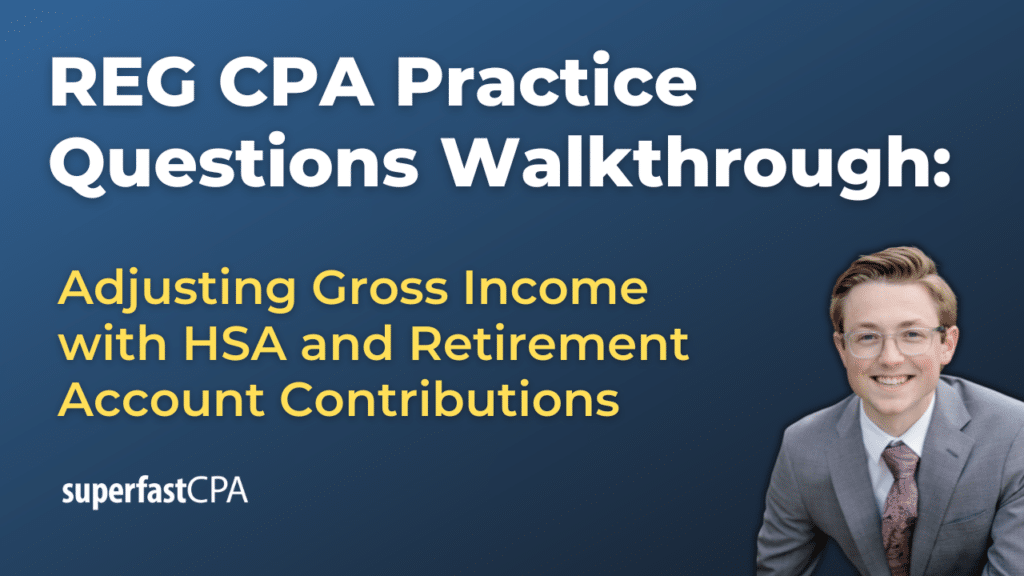In this video, we walk through 5 REG practice questions demonstrating adjusting gross income with HSA and retirement account contributions. These questions are from REG content area 4 on the AICPA CPA exam blueprints: Federal Taxation of Individuals.
The best way to use this video is to pause each time we get to a new question in the video, and then make your own attempt at the question before watching us go through it.
Also be sure to watch one of our free webinars on the 6 “key ingredients” to an extremely effective & efficient CPA study process here…
Adjusting Gross Income with HSA and Retirement Account Contributions
Two common methods to adjust or lower your AGI include contributions to Health Savings Accounts (HSAs) and retirement accounts, such as Individual Retirement Accounts (IRAs) and 401(k)s. Understanding how these contributions affect your AGI can help in planning for tax savings and future financial security.
Health Savings Accounts (HSAs)
An HSA is a tax-advantaged account designed for individuals with high-deductible health plans (HDHPs) to save for medical expenses. Contributions to an HSA are tax-deductible, meaning they can be subtracted from your gross income, thus reducing your AGI. This reduction in AGI can potentially qualify you for other tax deductions and credits that are dependent on your income level. The contributions are limited annually by the IRS, and the limits can change from year to year. Withdrawals from HSAs for qualified medical expenses are tax-free, adding to their tax efficiency.
HSA Example:
Imagine you are a single filer with a gross income of $60,000 per year. You are enrolled in a high-deductible health plan (HDHP) at work, making you eligible to contribute to an HSA. You decide to contribute $3,500 to your HSA for the year. HSA contributions are tax-deductible, which means they reduce your taxable income.
- Gross Income: $60,000
- HSA Contribution: $3,500
By contributing $3,500 to your HSA, you can subtract this amount from your gross income when calculating your taxable income.
- Adjusted Gross Income (AGI) after HSA Contribution: $60,000 – $3,500 = $56,500
Traditional IRAs
Contributions to traditional IRAs are often tax-deductible, directly reducing your AGI. However, the deductibility of these contributions is subject to phase-out limits based on your income, filing status, and whether you or your spouse are covered by a retirement plan at work. As your income increases, the amount you can deduct for your IRA contribution decreases until it phases out completely. This phase-out range varies annually, so it’s important to check the current limits. Traditional IRA contributions lower your taxable income for the year they are made, providing a tax break. The withdrawals during retirement are taxed as ordinary income.
Traditional IRA Example:
Suppose you are a single filer with a gross income of $50,000 for the year. You are considering making a contribution to a Traditional IRA. You decide to contribute $6,000 to your Traditional IRA for the year. This is the maximum amount you can contribute as of the last update, though the limit may change. Contributions to a Traditional IRA are typically tax-deductible, which means they can reduce your taxable income.
- Gross Income: $50,000
- Traditional IRA Contribution: $6,000
By contributing $6,000 to your Traditional IRA, you can subtract this amount from your gross income when calculating your taxable income.
- Adjusted Gross Income (AGI) after Traditional IRA Contribution: $50,000 – $6,000 = $44,000
Tax Impact
This reduction in AGI lowers your taxable income, which could not only place you in a lower tax bracket but might also make you eligible for other tax deductions and credits with phase-out limits based on AGI.
Additional Considerations
- Tax Deduction Phase-Outs: It’s important to note that if you or your spouse are covered by a retirement plan at work, the deductibility of your Traditional IRA contributions may be subject to phase-out limits based on your modified AGI. For this example, we are assuming the phase-out does not apply.
- Taxation Upon Withdrawal: Contributions to a Traditional IRA and the investment earnings grow tax-deferred. This means you won’t pay taxes on them until you make withdrawals in retirement, at which point the distributions are taxed as ordinary income.
- Required Minimum Distributions (RMDs): Starting at age 72, you are required to take minimum distributions from your Traditional IRA, which are also subject to ordinary income tax.
Roth IRAs
Roth IRA contributions are made with after-tax dollars, meaning they do not reduce your AGI in the year the contribution is made. Unlike traditional IRAs, there is no tax deduction for contributions. However, the advantage of a Roth IRA comes at retirement, as withdrawals of both contributions and earnings are tax-free, provided certain conditions are met. Roth IRAs have income limits for eligibility to contribute, but these do not affect your AGI since contributions are not deductible.
Nondeductible Traditional IRAs
For individuals who earn above the phase-out limits for traditional IRA deductions or who wish to contribute to an IRA despite having access to a workplace retirement plan, nondeductible traditional IRAs are an option. Contributions to a nondeductible IRA do not reduce your AGI since the contributions are made with after-tax money. The benefit of a nondeductible IRA comes from the tax-deferred growth of investments within the account. When you withdraw funds in retirement, only the earnings are taxed, not the contributions since those were already taxed at the time of contribution.













